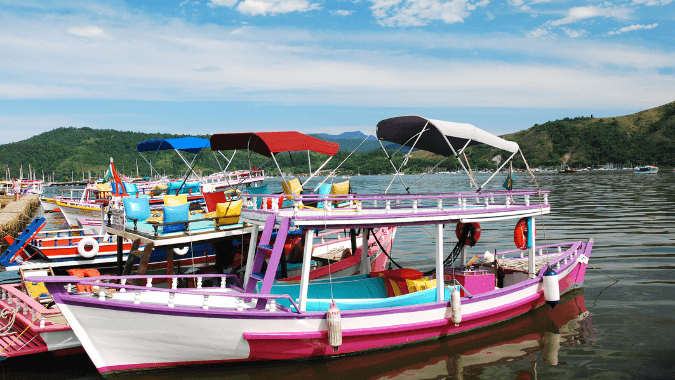Argentina
Wonders of the Argentine Northwest that you didn't know about
Tags:
Did you know that there is a geographical region located in the Northwest of Argentina that seems to be taken out of a movie? It is made up of the provinces of: Jujuy, Salta, Catamarca, Tucumán, La Rioja and Santiago del Estero, La Rioja and Santiago del Estero. It has a wealth of traditions and history. These six provinces allow us to know their dazzling festivals, their typical food, the distinguished wines, the great handicrafts and fabrics made with wool from llamas and vicuñas. But beyond that, what makes this region so special? There are probably things you still don't know about the northwest of Argentina and today we want to go further. Are you ready? ![]()
![]()
![]()
![]()
![]()
1- A reddish valley with shapes that look like melted candles
In the province of Salta
Precisely, being a little known site, it does not have an easy or consolidated access. There is no road to get there, other than walking. It is called Valle de Las Cuevas, a canyon of incredible rock formations of reddish sandstone of very intense tones, until arriving after about two hours to some caves that make it worth the whole journey. Precisely, the best way to describe them is as a corner where it seems that there are giant melted candles. They are also known as Cuevas de Acsibi, and are located in the town of Seclantás, in the Calchaquíes Valleys of the province of Salta.
Las Cuevas de Acsibi is a geographical feature located 15 km from the town of Seclantás in the Calchaquíes Valleys, in the province of Salta / Photo: source
2- Arizaro Salt Flat: An almost perfect natural cone in the middle of a salt flat.
Province of Salta
Due to its relative remoteness, it is not a massive destination for tourists, but there are excursions that are made from the city of Salta to visit the Arizaro Salt Flat, in the so-called Puna de Atacama. If in itself everything looks like another world because of the rarity of the landscapes, to this we must add the Cono de Arita, a formation that looks so regular and perfect that it does not seem natural. It stands about 200 meters high, appearing to be a pyramid (it is a cone) over the sea of salt. Travel tip: Those who want to discover this amazing destination can choose between hiring a guided tour or go on their own, following the coordinates on the map. It is very important to bring food and drinks (whose waste should be thrown in a garbage bag that each visitor will take with him on his return) and an empty camera memory, because it will.
The Salar de Arizaro, which is located more than 3,000 meters above sea level, is the third largest salt flat on the continent / Photo: Canva Pro
3- A town among the hills of Siete Colores
Jujuy Province
The Quebrada de Humahuaca is in this site in northwestern Argentina, one of the most curious and peculiar ranges of colors. It is the result of geological processes that include marine, lacustrine and fluvial sedimentation, with its final finish thanks to tectonic movements. A colorful geological experiment in a site recognized for its cultural and scenic values as a World Heritage Site. The town is called Purmamarca, is in the province of Jujuy, and has an architectural appearance of low adobe houses that look even more picturesque at the foot of a hill of seven colors, and in the context of colorful hills.
The Quebrada de Humahuaca, with villages of adobe houses and colorful mountains, is one of the great unknown jewels of Argentina / Photo: Canva Pro
4- A landscape that looks like the planet Mars
Province of Salta
Imagine a barely inhabited place, with a village of adobe houses in a landscape that averages 4,000 meters above sea level, with colors, shapes and textures that could well be the scenery of a landscape of the planet Mars. This is Tolar Grande, in the province of Salta. As a curious fact, we can mention that near Tolar Grande, a few years ago, some of the most amazing bacterial colonies in the world were found in the so-called sea eyes (deep salty lagoons at high altitude): the stromatolites, one of the oldest signs of life on Earth.
There are few places in the world like Tolar Grande. Volcanoes over 6,000 meters high, reddish-colored mountains, large salt flats of pure white and the blue of its sea eyes are some of its great attractions / Photo: Canva Pro
Travel tip: At more than 6,700 meters above sea level, the Llullaillaco Volcano is the highest archaeological site in the world. There, three frozen Inca children were found together with their ceremonial trousseau. Surrounded by a majestic landscape, it was recently declared a World Heritage Site by UNESCO, a must-see!5- Tilcara and its archaeological treasure
Province of Jujuy
Tilcara is considered the Archaeological Capital of Northwest Argentina (NOA) due to the great amount of objects that remain in its subsoil? It is a place where time seems to have stopped, where its inhabitants preserve many of the traditions and beliefs that their ancestors held many, many centuries ago. Its name is due to the ancient ethnic group of the Omaguaca and its zonal partiality: the Tilcara. At present, it has 10,300 inhabitants. Travel tip: Strolling through its dusty streets, chatting with the villagers and attending a popular folklore show in one of its numerous "peñas" will occupy a large part of your time.
Visit this city of Jujuy during the months of January and February, during the carnival season. You will not regret it / Photo: Canva Pro
Due to the characteristics of this region, these provinces are ideal to take a break and spend a few days in complete peace, contemplating the slow pace of local life, and enjoying a natural landscape and an intense blue sky as it is difficult to contemplate anywhere else. Are you up for it? Travel tip: Don't miss these new travel packages in Argentina4u so you can continue discovering the best regions of Argentina, book now!By: Nathaly Bosch, social communicator by profession and curious traveler by choice. Spanish editor for Daytours4u.
Tags:
Search
-
Exciting 4x4 route: São Luís and FortalezafromUS$1,014
-
Vila Gale Mares Resort All InclusivefromUS$100
-
Ecotourism in Chapada DiamantinafromUS$672
-
All inclusive Vila Gelé Cumbuco ResortfromUS$999
-
Full Day Cafayate Tour from SaltafromUS$68
-
Transfer Aeroparque - Buenos AiresfromUS$46
-
-
Transfer Ezeiza - AeroparquefromUS$91
-
-
Excursion to El Chaltén from El CalafatefromUS$153
-
-
-
-
-
-
-
-
-
-
-
Daytours4u © 2012-2019. Use of this website constitutes acceptance of the Terms & Conditions.
Open Chat
Hello, How May I Help You?



